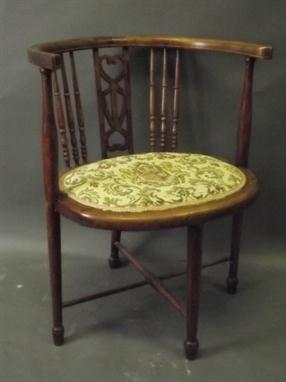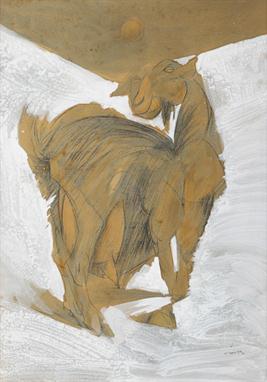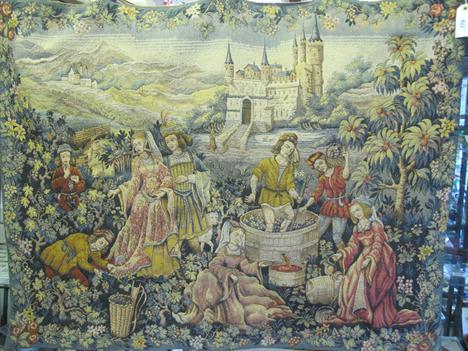We found 39442 price guide item(s) matching your search
There are 39442 lots that match your search criteria. Subscribe now to get instant access to the full price guide service.
Click here to subscribe- List
- Grid
-
39442 item(s)/page
A George III style walnut framed dressing table stool with floral tapestry seat on shell cut cabriole legs, 60 cm x 40 cm CONDITION REPORTS Wear and scuffs and scratches to legs which appear to have been varnished. Tapestry seat with wear, fading and dirt, some losses and some variations to colour and style of stitching.
A large and interesting collection of flatweave fragments and off-cuts, consisting mainly of European tapestry border pieces and other fragments, 17th century and later, small fragments of silk and wool embroideries and one small worn fragment of an 18th century Kerman ‘vase’ carpet. Sold as a collection with all faults not subject to return. (Approx. 73 all in one box).
An Aubusson seat cover, for a sofa, woven with a central spray of flowers, 68in. x 31in. 78cm. x 173cm. a tapestry seat cover for an armchair; a small needlework panel worked in wool in cross stitch; a silk and metal thread tapestry fragment and a needlework seat cover worked in cross stitch in wool on a linen ground. All late 19th/early 20th century. Sold as a collection with all faults not subject to return. (5)
Finnish rolled cotton rag runner, probably 19th century, 13ft.6in. x 2ft.2in. 4.11m. x 0.65m. A Finnish rolled cotton rag rug, probably 19th century, 5ft.8in. x 3ft.7in. 1.73m. x 1.10m. And a Japanese Sakiori (rolled rag rug), late 19th-early 20th century, 7ft.5in. x 2ft.8in. 2.26m. x 0.81m. The Japanese example with slight damage to both sides in places. N.B. Rolled rag rugs were first made in Japan, where they were known as Sakiori (lit. ‘rag weave’); the earliest Japanese examples, which represent an indigenous peasant art form, were woven in the mid 18th century using fragments of kimonos and other clothes (as they still do). The Japanese examples tend to be finer in construction than the Scandinavian examples and it is probable that the Scandinavian ones were based on Japanese examples imported into northern Europe either commercially or by returning travellers in the 19th century. They represent a fascinating aesthetic cross-current. Together with an Afshar sumac, south west Persia, modern 3ft.7in. x 1ft.11in. 1.10m. x 0.58m., two Bergama rugs, in double interlock tapestry weave, west Anatolia, modern, 3ft. x 2ft.1in. 090m. x 0.65m. and 1ft.11in. x 1ft.6in. 0.57m . x 0.44m. and an Anatolian machine-made ‘Art silk’ prayer rug, modern, 3ft.9in. x 1ft.10in. 1.15m. x 0.55m. Sold as a collection with all faults not subject to return. (7)
Needlebooks, pincushions, etc., comprising; a Sorrento ware needlebook inscribed “Tremezzo”, 8.2cm x 5.5cm, a Bristol card example, a tapestry pouch with wooden silk winder, a Bristol card bead decorated shoe pincushion with gilt paper borders, 6.5cm, a bellow form bodkin case, two thimble slippers, a pincushion in ceramic baby basket, and a turned wooden pin poppet. (9)
A Victorian woolwork tapestry panel of a girl by a tree, a house beyond, inscribed along the base “Sarah Bowerbank”, 30.5cm square, in a glazed oak frame, a late 19th century crewel work style pole screen panel of three birds amid flowers, in glazed octagonal mahogany frame, 36cm x 37.5cm, and a Victorian tapestry panel depicting Crystal Palace and dated ‘1851’, within a floral border, 22cm square, in a glazed gilt frame. (3)
Two samplers, a bag and other pieces, comprising; a small brightly worked sampler “Done by Elizabeth Mead Aged 11 Years 1843”, alphabet and numerals over a panel of male and female figures, each side of a table and chairs, within crowns, animals, etc., 21.5cm square, a tapestry bag “Money Bag”, 19cm x 18cm, a rectangular panel brightly worked with various stitches, effects and geometric patterns, 68cm x 24cm, together with a patchwork pyjama bag, 31cm x 45cm, a cut corner petit point panel of a bowl of flowers, 18cm,and an embroidered pad possible for a work box. (qty)
A SET OF TWENTY MAHOGANY DINING CHAIRS with moulded shield shaped back and boldly carved plume splat, serpentine seat rail and square tapering forelegs, the set including two elbow chairs, 97cm h, late 19th c Several chairs with old structural repairs; some joints loose; machine tapestry covered seats sagging but an attractive unrestored long set
Louis le Brocquy HRHA (1916-2012) ADAM AND EVE IN THE GARDEN, 1950-1952 colour-inverted Aubusson tapestry, Atelier René Duché; (no. 4 from an edition of 9) signed [leB] and dated [`52] lower left; signed with initials by maître-lissier, René Duché and numbered in the weave on reverse lower right; with Certificate of Authenticity sewn on reverse, signed, numbered, titled and dated by le Brocquy and Duché 55 by 108in., 139.7 by 274.32cm. Acquired directly from the artist by the present owner The genesis of le Brocquy`s colour-inverted tapestries pivots on his meeting with designer Jean Lurçat in the summer of 1952 in London where le Brocquy had established his studio, in Battersea, in spring that year. The innovations in the weaving industry coupled with his own earlier interest in the emotional effect of colour led him to explore the medium through the adaptation of early small-scale flat (gouache) cartoons. Between 1948 and 1952 these were translated into woven images facilitated by Tabard Frères et Soeurs, Aubusson and included Travellers, Garlanded Goat and the Eden series. In the artist`s notes in the catalogue for `Louis le Brocquy, Aubusson Tapestries`, 3-29 May 2001 with Agnew`s, he describes the process thus: "These tapestries were designed by means of a technique I learned directly from the master in this medium, Jean Lurçat. No colour sketch is involved. Instead a purely linear cartoon defines areas within which a range of coloured wools are indicated by numbers. But, further to these first cartoons, my excitement regarding the drama of colour-inversion encouraged me to make at the time second versions of these linear cartoons, inverted both in colour and tone."1 It would be fifty years before the artist could realise these second, colour-inverted, versions. The present tapestry was woven at Aubusson by celebrated Lissier René Duché in collaboration with the artist`s son, Pierre. They have been described as linking "… the refined simplicity of medieval weaving with the mastery of Cubist drawings" and by le Brocquy, as an "… inverted transformation of mood, `as contrary as night from day`".2 Footnote: 1. Exhibition catalogue for `Louis le Brocquy, Aubusson Tapestries`, Agnew`s, London, 3-29 May 2001, (Artist`s Notes; unpaginated) 2. Ibid "
Louis le Brocquy HRHA (1916-2012) GOAT IN THE SNOW, 1950 black ink and wash over pencil with gouache on tinted paper signed and dated lower right; numbered [668] and with "Gimpel Fils" inscribed on reverse; also with James Bourlet & Sons, Ltd. label on reverse; with original price [30gns] inscribed on reverse 22 by 16in., 55.88 by 40.64cm. Victor Waddington Galleries, Dublin; Private collection ‘Louis le Brocquy’, Victor Waddington Galleries, Dublin, 6-17 December, 1951, catalogue no. 19 Goat in Snow [30gns] The tapestry Garlanded Goat (limited ed.) woven by Tabard, Frères et Soeurs, Aubusson, France was also exhibited at the Waddington show as catalogue no. 13. The exhibition comprised 12 works in oil, 3 in tapestry, 16 in watercolour, 6 in pastel and 3 lithographs. "
Louis le Brocquy HRHA (1916-2012) THE TÁIN. MAGIC CHARIOT, 1991 Aubusson tapestry; Atelier René Duché; (no. 2 from an edition of 9) signed with initials in the weave on reverse by maître-lissier, René Duché and numbered lower right; with certificate of authenticity sewn on reverse, signed, numbered, titled and dated by le Brocquy and Duché 72.5 by 50.7in., 184.15 by 128.778cm. Taylor Galleries, November 2000; Private collection Whyte`s, 29 November 2005, lot 112; Private collection Louis le Brocquy: Aubusson Tapestries, Thomas Agnew & Sons, London, 2001, unpaginated (illustrated) Woven at the Atelier René Douche, France. One of a series of 22 tapestries based on le Brocquy`s 1969 illustrations to The Táin. Issued in a limited edition of nine plus two artist`s proofs. "I hope that these images from Táin Bó Cuailgne, transmuted into the woven forms of tapestry, may be seen as a tribute to the poet Thomas Kinsella, who inspired them and to the devoted publisher and designer, Liam Miller, who gave them their original coherence" (Louis le Brocquy, op. cit.). Louis le Brocquy was living in France with his young family when he received a life-changing invitation, in December 1966. Publisher Liam Miller wanted him to collaborate with Thomas Kinsella on a new translation of Ireland`s oldest saga. Le Brocquy penned an enthusiastic affirmative that Christmas Eve and spent much of the next three years visualising An Táin Bó Cúailgne. In September 1969, Dolmen Press published it as The Táin. The Táin was born of some eighty stories about the Ulaidh, a prehistoric people who lived in the north and north-western regions of what is now called Ireland. Part epic, part soap opera, the tales were vivid, vicious, inconsistent and often rather rude. Oral versions survived for long enough to be collected by scribes, whose fragmentary manuscripts are now in Trinity College and the Royal Irish Academy. Translators and writers such as Lady Gregory and W.B. Yeats had retold some of the Cúchulainn tales - and Joyce`s Finnegans Wake drew on its meandering style - but Thomas Kinsella`s Táin was the first widely-accessible version, especially when Oxford University Press` 1970 paperback followed the de luxe and limited editions produced by Dolmen Press. The Táin marked a unique cultural moment, for Ireland and the world. The State had just celebrated the 50th anniversary of the 1916 Rising and was driving ahead with Seán Lemass` Second Programme for Economic Expansion. By 1969 when it was published, Northern Ireland was in conflict, and global events such as the Prague Spring, the assassinations of Martin Luther King and Robert Kennedy, as well as wars in Vietnam, Angola and elsewhere, underlined its themes of invasion and carnage. Meanwhile, The Beatles sang "All You Need is Love." Its impact was instant. Although characters like Cúchulainn and Ferdia, Medb and Aillil, were local, the collaborators translated them into a crisply contemporaneous style that resonated through the cultural hierarchy. It engaged lovers of art, language, music and Celtic studies, as well as popular culture. The Táin became an Irish Iliad, with Cúchulainn as a Superhero reincarnating to a new age of rock, cartoons and animation. The images le Brocquy called `shadows thrown by the text` became so iconic that it is almost impossible now to imagine The Táin differently. Yet no one had visualised the full saga previously and no artist from Ireland had engaged so thoroughly with pieces of writing in so collaborative a way. Le Brocquy made hundreds of drawings, many of which appear in the de luxe and limited editions, with a handful printed in the paperback and a precious twenty in tapestry. Communication was difficult in those pre-digital days because he was in France and Miller was in Dublin, so that many key design decisions relied on sending letters through the post. Le Brocquy`s innovative, daring approach cast the saga as a virtual alphabet composed of spontaneous, inky letters. This shows immediately in Army Massing, where marks cascade in rivulets that resemble both chain mail and hand-writing, and in the H-shaped Cúchulainn confronting Ferdia. Different ages and cultures whisper through the images - and through the twenty tapestries made during 1998-2000, when le Brocquy collaborated with maître-lissier René Duché, whose firm had recently been awarded the honour Meilleur Ouvrier de France. Cuchulainn`s Warp Spasm, for example, speaks both of calligraphic marks from Sun Tzu`s The Art of War and Yves Klein`s bodily-marked Anthropometries, as well as cave paintings traced by prehistoric peoples. The translation into tapestry, via le Brocquy`s Táin lithographs, crested on the momentum from oral to written traditions, from drama to poetry and from visual culture to music. Duché`s subtly-textured cottons and wools freed le Brocquy`s black-on-white marks into a textured, sensual material that illuminates the sense of a blot or stain without definite edges, which is what he wanted. Here, the statuesque shapes let le Brocquy grow the book`s relatively modest scale into a life-affirming series of interconnected images that speak to each other like letters in a phrase or sentence. Le Brocquy`s hand reaches out through each one. Medb Ruane April 2012 "
Sampler, "Florence Mary Head, aged 10, 1892" with alphabet, Union Jack, ladybird, a small ship, little black cat and "The Lord is my Shepherd, I Shall Not Want", and "Even a Child is Known by His Doings", another similar by Florence Julia Pollock, aged 10, in 1863 and another similar, not named, together with a tapestry coat of arms, (4)
A Good Brussels Tapestry, late 17th/early 18th century Woven in silk and wool, depicting a huntsman sitting beneath a tree with his hound within a verdant wooded landscape, enclosed by rich borders of exotic birds fruits, leafy floral vines and plain indigo narrow outer borders, signed in the lower border EE Panmaker, 302cm by 196cm See illustration The Panmaker family are recorded as weaving in Brussels from the mid seventeenth century until 1720. Evidently they used more than one variation of the spelling of the family name.
-
39442 item(s)/page

















































